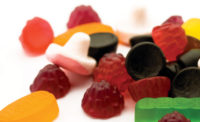
What is starch used for in confectionery?
Starch-based products have many uses in the confectionery industry:
a. Both modified and unmodified starches act as gelling agents in confectionery applications.All starch, regardless of the starch source -- i.e. corn, potato, tapioca, rice, sago, wheat, etc. -- is basically long polymers of glucose (a.k.a. dextrose) units that are arranged into discrete, highly organized, semi-crystalline aggregates called “starch granules”. These starch polymers within the “granule” are either straight-chain/linear (called AMYLOSE) or highly branched (called AMYLOPECTIN); starches vary by source in their amylopectin-to-amylose ratios.
In order to form a starch gel, the starch granules must be “gelatinized” (i.e. must be cooked (heat + water) to their “gelatinization temperature”, after which the crystalline structure of the granules is lost, and the granules begin to swell/take up water/increase in size and increase the viscosity of the aqueous system) and fully cooked out in the candy-making process to the point where the granules lose integrity/fragment/ rupture; when this cooked starch cools, the solubilized straight-chain amylose polymers re-align tightly to form a gel (a process known as retrogradation); you see these gelling starches most often used in jelly-type candies with a firm but tender, shorter/cleaner-breaking bite, i.e. jelly bean centers, gum drops, orange slices, spearmint leaves, licorice bites, etc.; “waxy” starches (100% amylopectin) are not used in starch jelly confectionery since they do not form a gel when cooked and cooled; typically all the starches used in jelly confectionery are the amylose-containing varieties; the higher the amylose content in the starch, the stronger the resulting gel; as you would expect, the high amylose corn starches form much stronger and much more rapidly setting gels versus starches containing less amylose.
Besides being used as the sole gelling agent in jelly confectionery, some of these gelling starches can also be used to partially replace/complement gelatin in gummy-type candies where a softer, less chewy/ less elastic texture is desired; potato starch is particularly suitable for this due to its higher degree of clarity and elasticity in the cooked form versus starches from other sources, such as corn or wheat.
b. Starches and starch-based products (such as low-DE maltodextrins), can also be used as texturizing agents in chewy-type candy; these types of products can be used to replace or complement more expensive and/or harder-to-source ingredients such as gelatin or gum arabic; these starches and maltodextrins can help to modify the chew characteristics of the candy (i.e. increasing the structure/body, softness, chewiness, and elasticity of the candy while reducing “toothstick”); they also help by inhibiting sugar recrystallization and reducing “cold flow”.
c. Modified starches and starch hydrolysis products, such as maltodextrins and dextrins, can be used for gum arabic/ gum tragacanth replacement in pan coating applications, as well as in hard candies/ cough drops/ lozenges and compressed tablet confectionery, due to their low hot viscosity at high solids, excellent film-forming, adhesion, and binding properties.
d. Starch (typically unmodified cook-up corn starch) with added mineral oil or high stability vegetable oil (typically corn starch with 0.03-0.10% mineral oil) functions as a moulding medium; the added oil allows the moulding starch to accept and hold impressions, into which molten/hot candy slurry can be deposited; the moulding starch also helps to absorb moisture from the deposited candy and it dries, cools, and sets.
e. In extruded marshmallows, starch can be added as an ingredient in the formulation to aid in the cutting and forming operation and helps the final product retain its shape (prevents “pillowing”); Starch (typically re-dried unmodified corn starch) also finds wide use as a dusting aid for marshmallows and other confections to prevent them from sticking together.
How have starches evolved over the years?
Starches have mainly evolved based on starch hybrid technology over the years.In an effort to increase production rates, candy manufacturers have moved away from using only traditional acid-thinned (thin-boiling) corn, wheat, and potato starches, etc., and toward using new, unique products employing combinations of traditional thin-boiling starches with hybrid corn starches containing 55-70% amylose (high amylose corn starches); this way, manufacturers can take advantage of the very low hot viscosity ( for ease of processing and depositing ) of the thin boiling starch coupled with the stronger and faster gelling of the high amylose corn starches after the candy has been deposited; this has enabled manufacturers to more easily and more rapidly turn around product; however, due to the opacity and firm/short set of these types of starches, it has not offered them a viable solution for gelatin replacement. Now starches are being developed based on potato that offer more gelatin-like qualities in terms of higher clarity and higher elasticity - areas where starches such as corn, high amylose corn, sago, and wheat have typically fallen short in the past.
Please explain the different kinds of starches. What are their pros/cons? What applications are they used in?
a. Unmodified (native) cook-up starches:Typically regular corn starch.Pros: Inexpensive, easily sourcedCons: noneApplications: Moulding and dusting starches
b. Thin-boiling (acid-thinned) starches:These types of starches go by several names that you may have heard of (“acid-thinned”/”thin-boiling”/”acid-converted”/”fluidity” starches), but they all mean the same thing -- the starch granules in their uncooked state have been treated with acid in a process designed to reduce the molecular weight (i.e. chop down the chain length) of the amylose and amylopectin backbones within the granule without disrupting the integrity of the uncooked granule itself -- i.e. this treatment does not cook out/disrupt the granule at all; it remains in the “cook-up” (insoluble) state after the treatment.The truly beneficial effect of acid treatment lies in the fact that it lowers the hot paste viscosity to a greater extent than it reduces gel strength (molecular weight is decreased but amylose content remains unchanged). This enables the use of acid-thinned starches at much higher levels than possible with the non-acid-treated (unhydrolyzed) parent starch. This low hot viscosity at high starch solids is critical in jelly gum processing since it enables the concentrated high-starch, high-sugar solution to be rapidly and efficiently cooked without difficulty in handling (i.e. pumping and deposition into moulds).Typically thin-boiling starches in the range of 60-75 fluidity (60-75 WF) are most commonly used in the jelly gum industry. “Fluidity” or “Water Fluidity (WF)” is a term which describes the inverse of viscosity. The higher the WF number, the lower the hot viscosity (i.e. the more FLUID it is), but also lower the gel strength (since the starch chains are more reduced in length). The trick is to balance out low hot viscosity with relatively high gel strength -- which can be achieved in the 60-75 WF range. Unmodified (non-acid-treated) starch has a WF=0, and would be too thick to process/deposit at the high concentration you would need in the jelly gum. Starches at higher fluidity (i.e. WF=90) would have very low hot viscosity at higher solids, but the gel strength would likely be reduced too greatly at this higher fluidity.
Pros: low hot viscosity; require lower cooking temps to fully cook vs. high amylose starches; can either use a “kettle-cooking” process or a continuous cooking (i.e. “jet cooking” or “tube cooking” process at 285°F); relatively inexpensive.
Cons: typically weaker gelling/slower gelling/ less gelling & acid stability vs. high amylose starches; with the exception of some of the modified potato starches, tend to give more opaque gels with less elasticity vs. gelatin
Applications: Gummy and jelly confectionery
c. High amylose corn starch:Hybrid corn variety containing 55-70% amylose; can be used either unmodified or chemically modified (i.e. acid-thinned and/or substituted by esterification or etherification to control retrogradation properties)
Pros: Give much stronger gels with faster setting times vs. acid-thinned starches with lower amylose content; increased drying rate for faster product turnaround.
Cons: Due to high amylose content and the higher bonding forces inside the granule, typically require higher cooking temps in the range of 330-340°F to gelatinize and fully cook (cannot use “kettle-cooking” process, typically only continuous cookers can be used); cannot be used by themselves at high levels since fast setting causes viscosity increase that creates “tailing” problems during depositing; typically need to be combined with lower-amylose-containing thin-boiling starches with lower hot viscosity; faster gelling rate requires more sophisticated handling; gives opaque gels vs. gelatin.
Applications: Gummy and jelly confectionery
d. Starch-hydrolysis products such as low-DE maltodextrins and dextrins:Starch backbone is reduced in length by acid or enzyme to reduce molecular weight and viscosity/ increase DE; dextrins have varying solubilities and solution stabilities.
Pros: Texture modification in chewy candy; replacement of more expensive hydrocolloids such as gelatin, gum arabic, and gum tragacanth; have low viscosity at high solids, excellent binding properties, and form glossy, resilient films for use in pan-coating and in hard candies/lozenges/cough drops/ compressed tablet confectionery.
Cons: since some of these products are instantized, may require good mixing in order to properly disperse these products.
Applications: Chewy candy; Pan-coating; Hard candies/ Lozenges/ Compressed Tablet Confectionery
e. Pregelatinized or Cold-Water-Swelling instant viscosifying starches:Both modified and unmodified starches which have been made into instant powders through drum-drying or spray-cooking processes; these do not require cooking and will give cold viscosity.
Pros: Do not need to be cooked in the process, but can withstand further heating based on the starch’s process tolerance; gives structure, body, viscosity, and moisture-binding properties to the system.
Cons: Since they are instant and will give cold viscosity, need good mixing in order to properly disperse these products and avoid lumping.
Applications: Cold-extruded chewy candy; fudge; marshmallows
Which starches does your company provide?
Main confectionery lines:-FLOJEL® line of thin-boiling corn starches; ELASTIGEL® 1000J thin-boiling sago starch.-HYLON®, HI-SET®, SUPERSET®, ULTRA-SET® starches - line of unmodified or modified high amylose corn starch-containing products.-PERFECTAMYL® GEL/ PERFECTAGEL®/ AMYLOGUM® - lines of modified potato starches.-NU MOULD™ -moulding starch
What kinds of requests do you get from confectioners?
Most of the recent requests from confectioners have been about gelatin (and to a lesser degree, pectin) replacement in gummy candies, for the following reasons: cost savings, labeling (vegetarian, kosher, halal), and/or for texture modification; there have also been requests for both gelatin and gum arabic replacement, and for texture modification, in chewy candies; additionally confectioners have been requesting alternatives for gum arabic and gum tragacanth in pan coating and hard candy applications, due to either to pricing and/or difficulty in sourcing these hyrocolloids.
What is the difference between starches and natural starches?
Although “all-natural” is not a well-defined term, typically “all-natural starches” refer to either cook-up or instantized starches that have not been modified at all using chemical reagents -- and that label according to just their base starch, i.e. Corn Starch, Potato Starch, Tapioca Starch, Rice Starch, etc.
In jelly and gummy candies, chemically modified (i.e. acid-thinned) starches are almost exclusively used since they allow for a low enough hot viscosity (for easy depositing and handling) at the high solids levels needed to form a strong starch gel in the candy. If you were to use a non-acid-thinned starch for a jelly candy, you would likely be unable to deposit the candy due to the extremely high viscosity at higher use levels.
Are many gummy and jelly manufacturers using starch versus gelatin in their products for the vegetarian claim? How can starches replace other texturizing ingredients?
For vegetarian/halal/ kosher products, manufacturers are turning to starch and pectin as alternative gelling agents.
Mostly manufacturers are turning to starch to help them reduce gelatin usage for cost-savings purposes, especially in the case of kosher gelatin, which is very expensive. Others are looking to use starch as a way to modify the texture of a 100%-gelatin gummy candy, in order to make it less firm, chewy, and elastic, and to make it slightly more tender and soft, with a cleaner-breaking bite.
Potato starches, with their increased clarity and elasticity over other starches, are typically the starch-of-choice when it comes to gelatin replacement applications.
How do you expect starches to change for the future?
I think as far as traditional jelly candies go, manufacturers will mostly continue to stick with the “tried-and-true” traditional thin-boiling and high-amylose-corn-based starches that have worked best in their established processes and that offer the textures that consumers have come to know and love.
I believe areas of starch innovation in the near future will likely focus on developing starches that more closely approach and clarity and elasticity/texture of gelatin in gummy and chewy candy, due to the high demand from manufacturers to reduce their overall gelatin usage -- due mostly to cost and/or labeling issues. From what I have seen, potato starches currently offer the most promise in this area; as we learn more and more about how to manipulate their texture and clarity, we should be able to develop starch products that can more ably function as true gelatin replacers.



